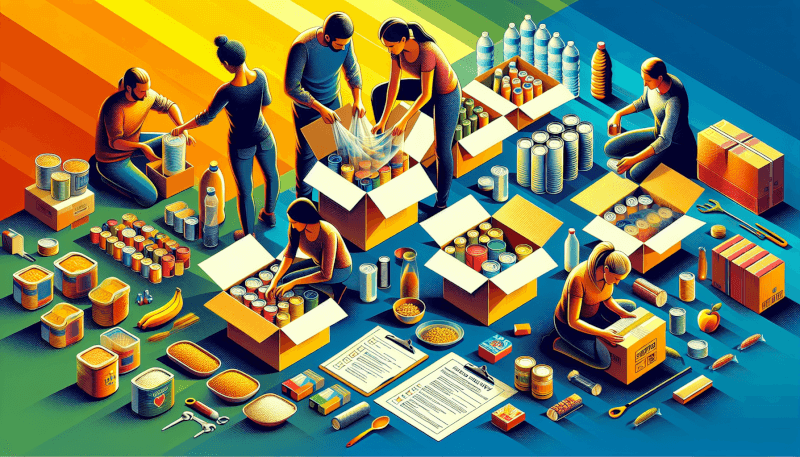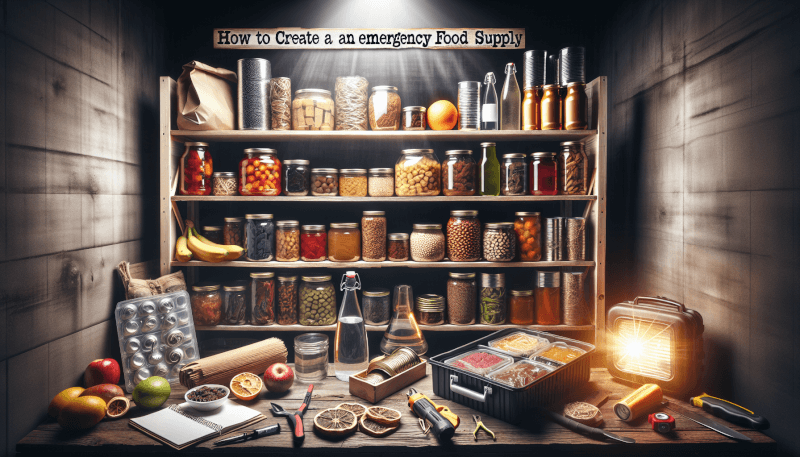In times of emergency, having a well-stocked supply of food can provide comfort and security. Whether it’s a natural disaster or a sudden crisis, knowing how to create an emergency food supply is essential. This article will guide you through the steps of building your own supply, offering tips on food storage, rotation, and the types of foods to include. By taking the time to prepare now, you can ensure that you and your loved ones are prepared for any unforeseen circumstances that may arise.

Choosing the Right Storage Location
Whether you are preparing for a natural disaster or simply want to have a well-stocked pantry, choosing the right storage location is essential. There are a few key considerations to keep in mind when deciding where to keep your emergency food supply.
Temperature and Humidity
One of the most important factors in storing food long-term is the temperature and humidity of the storage area. It is best to keep your emergency food supply in a cool, dry place. Extreme heat can cause food to spoil more quickly, while high humidity can lead to mold and bacteria growth. Avoid storing food in areas like the garage or attic, where temperature fluctuations are common.
Accessibility and Convenience
When disaster strikes, you want to be able to access your emergency food supply quickly and easily. Choose a storage location that is both accessible and convenient. Consider storing your food in a dedicated area of your kitchen or pantry, making it easily accessible in case of an emergency. Additionally, ensure that the stored food does not obstruct any pathways or interfere with other items.
Determining the Quantity of Food Needed
Once you have chosen the right storage location, it’s time to determine how much food you will need for your emergency supply. There are a few factors to consider when calculating the quantity of food needed.
Calculate the Number of Meals Needed
Start by calculating the number of meals you will need to cover during an emergency. Consider a timeframe of at least two weeks, as this will provide you with an ample food supply in most situations. Take into account the number of people in your household, as well as their appetites and dietary needs.
Consider Dietary Needs and Restrictions
When stocking your emergency food supply, it’s crucial to consider any dietary needs and restrictions. If you or a family member has food allergies or intolerances, make sure to stock up on suitable alternatives. Likewise, if you follow a specific diet, such as vegetarian or vegan, ensure that you have enough plant-based options available.
Account for the Number of People in the Household
The number of people in your household is a critical factor in determining the quantity of food needed for an emergency supply. Be sure to factor in the appetites of each individual and any potential guests or extended family members who may be staying with you. It is better to have extra food than not enough, so err on the side of caution when estimating quantities.

Types of Long-lasting Foods to Stock Up On
Now that you have determined how much food you will need, it’s time to stock up on the right types of long-lasting foods. Here are some essential items to include in your emergency food supply.
Canned Goods
Canned goods are a staple in emergency food supplies due to their long shelf life and ease of storage. Stock up on canned fruits, vegetables, beans, and proteins like tuna and chicken. These items provide essential nutrients and can be eaten as standalone meals or incorporated into recipes.
Dried Grains and Legumes
Dried grains and legumes are a great source of carbohydrates, protein, and fiber. Stock up on items like rice, quinoa, lentils, and beans. These foods have a long shelf life and can be cooked in various ways to provide a filling and nutritious meal.
Powdered Milk and Eggs
In addition to canned goods and grains, it is essential to have a source of dairy and protein in your emergency food supply. Powdered milk and eggs are convenient options as they have a long shelf life and can be easily reconstituted with water. These items can be used for cooking or as standalone beverages.
Building a Diverse Food Inventory
When assembling your emergency food supply, it’s important to include a diverse range of foods to provide balanced nutrition and avoid food fatigue. Here are some tips for building a diverse food inventory.
Include a Variety of Food Groups
Make sure to include foods from all major food groups in your emergency supply. Aim to have a balance of fruits, vegetables, proteins, grains, and dairy alternatives. This will ensure that you have a well-rounded selection to meet your nutritional needs.
Consider Seasonings and Condiments
To add flavor and variety to your meals, don’t forget to include a selection of seasonings and condiments. Stock up on salt, pepper, spices, and sauces to enhance the taste of your emergency meals. These small additions can make a big difference in your overall satisfaction with your food supply.
Account for Special Dietary Requirements
If you or your family members have special dietary requirements, consider stocking up on specific items that cater to those needs. Gluten-free alternatives, low-sodium options, and other specialized products can ensure that everyone’s dietary needs are met during an emergency.

Storing Water as Part of Emergency Supplies
In addition to food, it is crucial to have an adequate supply of water as part of your emergency supplies. Here are some important considerations when storing water for emergencies.
Determine the Water Needs per Person
The general rule of thumb for water storage is to have at least one gallon of water per person per day. This amount should cover both drinking and sanitation needs. Keep in mind that you may need more water during the hotter months or in case of extreme circumstances.
Use Proper Containers for Water Storage
When storing water for emergencies, it is essential to use proper containers that are safe and suitable for long-term storage. Food-grade plastic containers or glass bottles are recommended. Avoid using containers that previously held chemicals or non-food substances, as they may contaminate the water.
Store Water in Multiple Locations
To ensure access to clean water during an emergency, it is advisable to store water in multiple locations. Consider dividing your water supply between your home, workplace, and other frequented areas. This redundancy will be beneficial in case one location becomes inaccessible.
Organizing and Rotating Food Supplies
Proper organization and rotation of your emergency food supplies are crucial to maintain their freshness and ensure that nothing goes to waste. Follow these steps to keep your food inventory organized and up to date.
Establish a Clear Labeling System
Before storing your food, establish a clear labeling system to keep track of the expiration dates and contents of each item. Use markers or labels to indicate the date of purchase and expiration, making it easy to identify which items need to be used or replaced first.
FIFO Method for Food Rotation
To prevent food from spoiling, practice the FIFO (first-in, first-out) method when organizing your supplies. This means using the oldest items first, making room for new purchases at the back of your storage area. By consistently rotating your food, you ensure that nothing sits for too long and risks expiring.
Check Expiration Dates Regularly
Regularly check the expiration dates on your food supplies and discard any items that have passed their expiration date. Make it a habit to perform these checks every few months to ensure that your emergency food supply remains fresh and safe to consume.

Choosing the Right Food Storage Containers
When it comes to storing your emergency food supply, choosing the right containers is essential for maintaining freshness and preventing spoilage. Consider the following factors when selecting food storage containers.
Consider Material and Durability
Choose containers made from durable materials that can withstand temperature changes and resist pests. Opt for food-grade plastic or glass containers that are BPA-free and will not leach chemicals into your food over time.
Opt for Airtight Containers
To preserve the freshness and quality of your emergency food supply, select airtight containers that provide a secure seal. This will protect your food from moisture, air, and pests, ensuring that it remains safe to eat for an extended period.
Use Food-Grade Storage Containers
When it comes to storing food long-term, it is essential to use food-grade storage containers that are specifically designed for this purpose. These containers are made to meet strict safety standards and are less likely to interact with or contaminate your food.
Creating a Meal Plan for Emergency Situations
Having a well-thought-out meal plan for emergency situations can help you make the most of your stored food supplies. Here are some tips for creating a meal plan that balances nutrition and meets your dietary needs.
Balancing Nutrition in Meals
When planning your emergency meals, strive to create a balanced mix of proteins, carbohydrates, fats, and vegetables. Aim to include a variety of food groups in each meal to ensure that you are getting all the necessary nutrients.
Creating a Sample Menu
To make meal planning easier, create a sample menu that includes breakfast, lunch, dinner, and snacks. This will help you visualize the meals you can prepare with your emergency food supplies and ensure that you have a well-rounded selection.
Adapting Recipes for Limited Ingredients
In emergency situations, you may not have access to all the ingredients typically used in your favorite recipes. Flexibility is key. Be prepared to adapt and substitute with the items you have on hand. Experiment with different combinations and get creative with your meals to make the most of your food supply.

Considering Special Dietary Needs
When creating an emergency food supply, it’s important to consider any special dietary needs within your household. Here are some factors to keep in mind.
Take Note of Allergies and Intolerances
If you or a family member has allergies or intolerances, be sure to stock up on suitable alternatives. Look for allergen-free options and ensure that any cross-contamination risks are minimized during storage and preparation.
Accommodate Medical Conditions
If someone in your household has a specific medical condition, such as diabetes or high blood pressure, make sure to include appropriate foods that cater to their dietary needs. Consult with a healthcare professional if you need guidance on suitable options.
Vegetarian and Vegan Alternatives
If you or your family members follow a vegetarian or vegan diet, make sure to have plant-based alternatives in your emergency food supply. Include foods like tofu, plant-based proteins, and a variety of fruits and vegetables to ensure nutritional balance.
Emergency Food Supply on a Budget
Creating an emergency food supply doesn’t have to break the bank. Here are some tips for building your supplies on a budget.
Buying in Bulk
Buying in bulk is an excellent way to save money when building your emergency food supply. Look for sales or purchase items in larger quantities to take advantage of lower prices. Non-perishable items like canned goods, grains, and legumes are great candidates for bulk purchases.
Choosing Cost-effective Options
Not all emergency food supplies need to be gourmet. Look for cost-effective options that still provide essential nutrients. Generic or store-brand items can often be just as nutritious as their higher-priced counterparts.
Growing Your Own Produce
One way to save money and ensure a fresh supply of produce is to grow your own. Consider starting a small vegetable garden or growing herbs indoors. This can provide you with a cost-effective and sustainable source of fresh food during an emergency.
In conclusion, creating an emergency food supply is an essential step in being prepared for unforeseen circumstances. By choosing the right storage location, determining the quantity of food needed, stocking up on long-lasting food items, organizing and rotating supplies, and considering special dietary needs, you can ensure that your family has an adequate and well-balanced food supply during emergencies. Remember to regularly check expiration dates, store water in multiple locations, and plan meals to make the most of your supplies. With careful planning and consideration, you can have peace of mind knowing that you are prepared to weather any storm.


